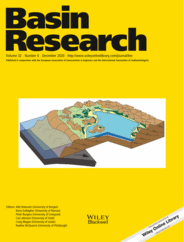
Full text loading...
 , Stéphane Polteau3,4
, Stéphane Polteau3,4
The thermal evolution of sedimentary basins is usually constrained by maturity data, which is interpreted from Rock‐Eval pyrolysis and vitrinite reflectance analytical results on field or boreholes samples. However, some thermal evolution models may be inaccurate due to the use of elevated maturities measured in samples collected within an undetected metamorphic contact aureole surrounding a magmatic intrusion. In this context, we investigate the maturity and magnetic mineralogy of 16 claystone samples from Disko‐Svartenhuk Basin, part of the SE Baffin Bay volcanic margin. Samples were collected within thermal contact metamorphic aureoles near magma intrusions, as well as equivalent reference samples not affected by intrusions. Rock‐Eval pyrolysis (Tmax), and vitrinite reflectance (Ro) analysis were performed to assess the thermal maturity, which lies in the oil window when 435°C ≤ Tmax ≤ 470°C and 0.6%–0.7% ≤ Ro ≤ 1.3%. In addition, we performed low‐ (<300K) and high‐temperature (>300K) investigations of isothermal remanent magnetization to assess the magnetic mineralogy of the selected samples. The maturity results (0.37% ≤ Ro ≤ 2%, 22°C ≤ Tmax ≤ 604°C) show a predominance of immature to early mature Type III organic matter, but do not reliably identify the contact aureole when compared to the reference samples. The magnetic assemblage of the immature samples consists of iron sulphide (greigite), goethite and oxidized or non‐stoichiometric magnetite. The magnetic assemblage of the early mature to mature samples consists of stoichiometric magnetite and fine‐grained pyrrhotite (<1 μm). These results document the disappearance of the iron sulphide (greigite) and increase in content of magnetite during normal burial. On the other hand, magnetite is interpreted to be the dominant magnetic mineral inside the contact aureole surrounding dyke/sill intrusions where palaeotemperatures indicate mature to over‐mature state. Interestingly, the iron sulphide (greigite) is still detected in the contact aureole where palaeotemperatures exceeded 130°C. Therefore, the magnetic mineralogy is a sensitive method that can characterize normal burial history, as well as identify hidden metamorphic contact aureoles where the iron sulphide greigite is present at temperatures beyond its stability field.
,Model showing the formation of magnetic mineral as a function of organic matter maturity and temperature. The maturity of the different samples is well constrained by Rock‐Eval pyrolysis and vitrinite reflectance.

Article metrics loading...

Full text loading...
References


Data & Media loading...

